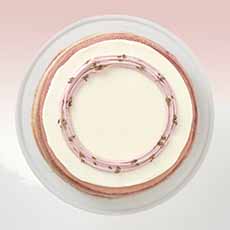|
Queso is the Spanish word for cheese, but in Mexico, it also refers to a warm cheese dip, a truly great comfort food. We’ve got a queso fundido recipe below.
Queso fundido is a rich Mexican comfort food dish that’s typically served as an appetizer. It consists of pieces of chorizo, tomatoes, onions, poblano peppers, and gooey melted cheese.
The standard queso dip found in the U.S. is a simpler, Tex-Mex variation of queso fundido (molten cheese), a thick sauce of melted cheese seasoned with chorizo and spices. The goal is a bubbling dish of stringy melted cheese (photo #7).
Some recipes fold in chorizo, chopped tomatoes or strips of roasted red peppers and/or green poblano or Hatch chiles, sautéed mushrooms, and/or onions.
Some are topped or blended with pico de gallo salsa (photo #1).
Some top the queso with dried beef, guacamole, refried beans, or a combination.
Some restaurants present the dish as queso flameado (flamed cheese—photo #6), bringing the hot cheese to the table to flambé with brandy, rum, or tequila.
Some serve the queso with a side of pickled vegetables—carrots, cauliflower, celery, and cauliflower, plus olives (photo #5).
A variation, chile con queso (chile with cheese), sometimes simply called queso, adds chile peppers to the melted cheese.
If you order simply “queso,” you may get a bowl of queso fresco, just plain melted cheese (photo #2). Not that there’s anything wrong with that!
> The recipe is below.
> So is the history of queso dip.
> The history of cheese.
> The different types of cheese: a photo glossary.
> The year’s 30 cheese holidays. (March 23 is National Chip & Dip Day.)
> There are links to 85 additional Hispanic recipes below, for Cinco de Mayo or any occasion.
HOW TO SERVE QUESO DIP
Whichever version of queso you choose, it’s typically served hot with tortilla chips or warm corn tortillas. You can also:
Serve it as part of a “tortilla chip buffet” with different salsas and guacamole (photo #4).
Pour it as a sauce—over burritos, on nachos and other Tex-Mex foods as well as on grilled poultry and other foods.
Use it as a sandwich dip.
Dip crudités, French fries, pretzel bites, etc.
> Recipe: Short Rib Chilaquiles With Queso Fundido & Pickled Red Onion
> Recipe: Green Chile Queso Fundido
THE HISTORY OF QUESO DIP
The dish is said to have originated sometime in the 19th century (if not before), around the borders of northern Mexico and the southwestern U.S., as a campfire dish [source]. The first known recipe dates to 1896 [source].
The recipe was published in a California-based magazine, The Land of Sunshine. At the time, European-style fondue was rising in popularity in the U.S., which possibly could account for the idea behind the Mexican cheese dip.
Menus from the decades that followed the publication show that chile con queso was served at restaurants in San Antonio, and then expanded beyond. Recipes for queso dips in cookbooks and community publications became more commonplace.
Texas had been a part of Mexico from 1821 to 1836, and became America’s 28th state in 1845. Mexican heritage and cuisine were an important part of Texas culture.
As a result, there is speculation that the queso we know today was developed to make Mexican food more Anglo-American dishes, and thus acceptable to consumers who didn’t want “foreign food” [source].
In modern times, you can find queso dips ready-made in a jar for heating and dipping (or pouring). Cacique, Old El Paso, Pace, Tostitos, and Whole Foods 365 are some brands to look for (photo #8).
WHAT CHEESES TO USE IN A QUESO DIP
Chef Alberto Gonzalez of Grizzelda’s in Austin, Texas, makes his queso fundido combines stretchy Oaxaca cheese, Manchego and Chihuahua cheeses. Melting the ingredients in a skillet on the stove, he adds grilled poblano and red bell peppers, combined with milk and heavy cream to achieve a melty cheesiness. Here’s his recipe.
But as with cheese fondue, you can customize your recipe as you wish. Mexican Oaxaca cheese and Chihuahua cheese are popular.
Check out these Hispanic melting cheeses, but melt your favorites. You can end up with a multinational combination:
Cheddar (English), Havarti (Dutch), Monterey Jack, Muenster, or Pepperjack (American).
Other good melters: Colby (American), Edam (Dutch), Emmental (Swiss), Monterey Jack Cheese (American), Tilsit (Prussian/Germany), whole milk mozzarella (Italy).
As blending cheeses, you can add those that aren’t stringy/melty by nature, but add particular flavors you’d like, such as goat cheese and Parmesan (you can find hard goat cheese to grate, such as Garrotxa and Queso de Murcia al Vino from Spain, and aged goat Gouda from The Netherlands).
Many queso recipes in the U.S. use American cheese (the Kraft type), even Velveeta. It’s edible, but not our kind of edible.
Melt on the stovetop or in the oven. While melting cheese in the microwave may seem to be the easiest option, you won’t be happy with it. The cheese comes out of the microwave hot and melty, but in two minutes the texture becomes rubbery (not enjoyable!).
RECIPE: QUESO FUNDIDO
Prep time is 20 minutes. Thanks to Roth Cheese for the recipe. They used their delicious Roth Original Havarti cheese, but you can use any of the cheeses mentioned above.
Ingredients For 2-1/2 Cups
2 tablespoons butter, cubed
2 tablespoons all-purpose flour
1-1/2 cups milk
1 teaspoon each of garlic powder, onion powder, and ground cumin
10 ounces shredded (2-1/2 cups) cheese of choice
1-1/2 cups pico de gallo, drained
Optional mix-ins: 8 ounces crumbled and cooked chorizo, 1 cup corn kernels, 2 scallions thinly-sliced, chopped fresh chiles to taste
For serving: tortilla chips, crudités
Preparation
1. MELT the butter in a large saucepan over medium-low heat. Whisk in the flour until light brown. Gradually whisk in the milk, garlic powder, onion powder, and cumin.
2. BRING to a boil. Cook and whisk for 2 minutes or until thickened. Reduce the heat to low. Gradually whisk in havarti until melted.
3. REMOVE from the heat. Stir in the pico de gallo. Serve with tortilla chips.
85 MORE CINCO DE MAYO RECIPES
DRINKS
30+ Margarita Recipes
Bandera Tequila Shots
Chipotle Beer
Cinco Punch
Coconut Rum Margarita
Cucumber-Apple Agua Fresca
Michelada
Paloma Cocktail (recipe above)
Spicy Lemonade
Tequila Cocktail Recipes #1
Tequila Cocktail Recipes #2
Tropical Agua Fresca
Make Your Own Chile-Infused Tequila
BREAKFAST
Fried Egg Quesadilla
Skillet Cornbread
Taco Eggs
Turkey Chorizo Scrambled Eggs
LUNCH
Deconstructed Enchilada Salad
Mexican Pulled Pork Sandwiches
Mexican Torta Sandwich
APPETIZERS – FIRST COURSES
Bacon Guacamole
Beer & Salsa Bar
Ceviche acapulqueño
Chili Cornbread Layered Salad
Chipotle Meatballs
Guacamole Trio
Hispanic Cheeses With Hot Pepper Mango Salsa
Homemade Salsa
Jalapeño Poppers
Lobster Guacamole #1
Lobster Guacamole #2
Mango Guacamole
Menudo Soup
Mexican Chicken & Rice Soup
Mexican Fiesta Won Tons
Mexican Haystacks
Mexican Hummus
Nacho Cheesecake
Nachos Fully Loaded
Naked Nachos & Skillet Nachos
Prickly Pear Salad Dressing
Salsa Fresca
Savory Chocolate Gazpacho
Savory Mexican Parfait
Tomatillo Guacamole
Tex-Mex Queso Dip
Tortilla Chips & Steak Bites
Uses For Tortilla Chips At All Meals
MAINS & SIDES
Chicken Enchiladas
Chicken Enchiladas Casserole
Cinco de Mayo Baked Potatoes
Corn & Bean Salsa Baked Potatoes
Enchiladas Suizas
Fish Veracruz Style
Fried Plantains
Gourmet Chilaquiles
Grilled Chicken Or Fish With Pico De Gallo
Homemade Corn Tortillas
Homemade Flour Tortillas
Homemade Tacos
Jalapeño Compound Butter
Jalapeño Pasta Bake
Jicama Salad
Mexican Lasagna
Mexican Meatloaf
Pork Pozole
Potato Wedge Nachos
Red Pepper Sour Cream Garnish
Tortilla Soup
DESSERT
Baked Churros
Biscochitos Cinnamon Bookies
Chile & Chocolate Fondue
Chocolate Churros
Cinco de Mayo Strawberries
Churros Recipe Ideas
Dessert Nachos
Dulce De Leche Cookies
Dulce De Leche Rice Pudding
Grilled Mango Bowls With Ice Cream
Ice Cream Tacos
Margarita Chile Cheesecake Bars
Mexican Cheese Course
Spicy Chocolate Fondue
Tres Leches Cake
ALSO CHECK OUT:
Cinco de Mayo Cocktail Party
Hispanic Cheeses: How To Use Them
Sweet & Heat Pairings
|
|
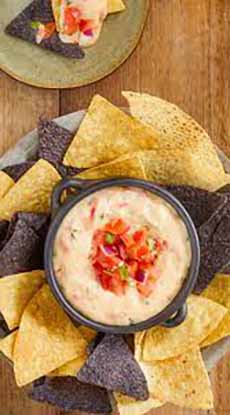
[1] Queso dip with salsa (photo © Wisconsin Cheese).
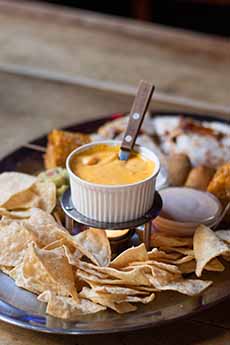
[2] A classic queso dip kept warm with a tea candle (photo © Valeria Boltneva | Pexels).

[3] Hatch chile queso fundido. Here’s the recipe (photo © Melissa’s Produce).

[4] Queso dip with red and green salsas, guacamole, and refried beans (photo © Frankie Lopez | Unsplash).
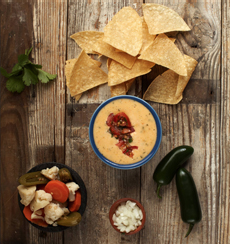
[5] Queso dip garnished with salsa, served with pickled carrots, cauliflower, and (photo © El Original | New York City [permanently closed]).

[6] Queso flameado, flaming queso dip (photos #6 and #7 © Grizzelda’s | Austin).

[7] A simple queso garnished with cilantro and jalapeño.
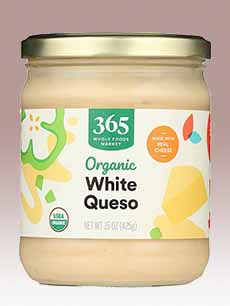
[8] Whole Foods private label queso is organic (photo © Whole Foods Market).
|










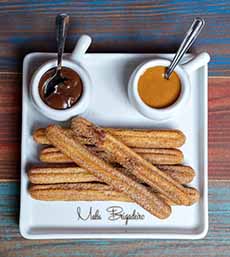
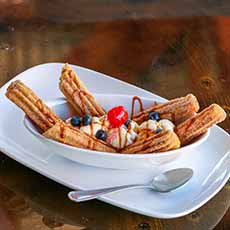

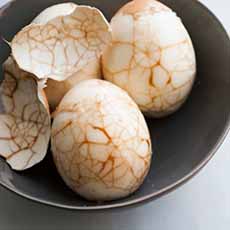



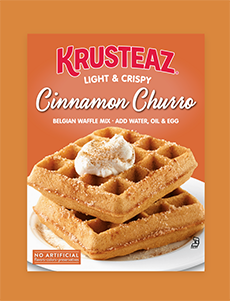
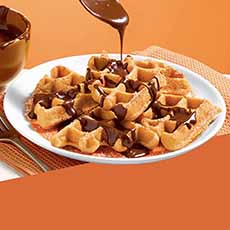
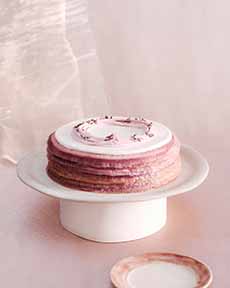 Lavender Mille Crepes Cake[/caption]
Lavender Mille Crepes Cake[/caption]
